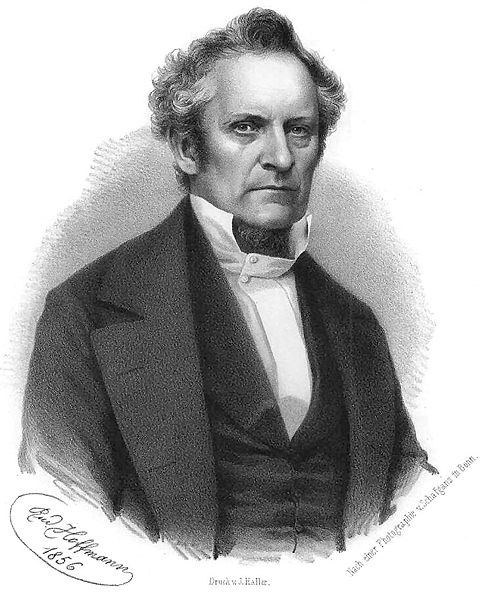<Back to Index>
- Mathematician Julius Plücker, 1801
- Painter John Linnell, 1792
- Lord High Chancellor of Sweden Axel Gustafsson Oxenstierna af Södermöre, 1583
PAGE SPONSOR

Julius Plücker (16 June 1801 – 22 May 1868) was a German mathematician and physicist. He made fundamental contributions to the field of analytical geometry and was a pioneer in the investigations of cathode rays that led eventually to the discovery of the electron. He also vastly extended the study of Lamé curves.
Plücker was born at Elberfeld (now part of Wuppertal). After being educated at Düsseldorf and at the universities of Bonn, Heidelberg and Berlin he went to Paris in 1823, where he came under the influence of the great school of French geometers, whose founder, Gaspard Monge, was only recently dead. In 1825 he returned to Bonn, and in 1828 was made professor of mathematics. In the same year he published the first volume of his Analytisch-geometrische Entwicklungen, which introduced for the first time the method of abridged notation. In 1831 he published the second volume, in which he clearly established on a firm and independent basis projective duality.
In 1836 Plücker was made professor of physics at University of Bonn. In 1858, after a year of working with vacuum tubes of his Bonn colleague Heinrich Geissler, he published the first of his classical researches on the action of the magnet on the electric discharge in rarefied gases. He found that the discharge caused a fluorescent glow to form on the glass walls of the vacuum tube, and that the glow could be made to shift by applying an electromagnet to the tube, thus creating a magnetic field. It was later shown that the glow was produced by cathode rays.
Plücker, first by himself and afterwards in conjunction with Johann Hittorf, made many important discoveries in the spectroscopy of gases. He was the first to use the vacuum tube with the capillary part now called a Geissler tube, by means of which the luminous intensity of feeble electric discharges was raised sufficiently to allow of spectroscopic investigation. He anticipated Robert Wilhelm Bunsen and Gustav Kirchhoff in announcing that the lines of the spectrum were characteristic of the chemical substance which emitted them, and in indicating the value of this discovery in chemical analysis. According to Hittorf he was the first who saw the three lines of the hydrogen spectrum, which a few months after his death were recognized in the spectrum of the solar protuberances.
In 1865 Plücker returned to the field of geometry and invented what was known as line geometry in the nineteenth century. In projective geometry, Plücker coordinates refer to a set of homogeneous co-ordinates introduced initially to embed the set of lines in three dimensions as a quadric in five dimensions. The construction uses 2×2 minor determinants, or equivalently the second exterior power of the underlying vector space of dimension 4. It is now part of the theory of Grassmannians, to which these co-ordinates apply in generality (k-dimensional subspaces of n-dimensional space).
Plücker was the recipient of the Copley Medal from the Royal Society in 1866.